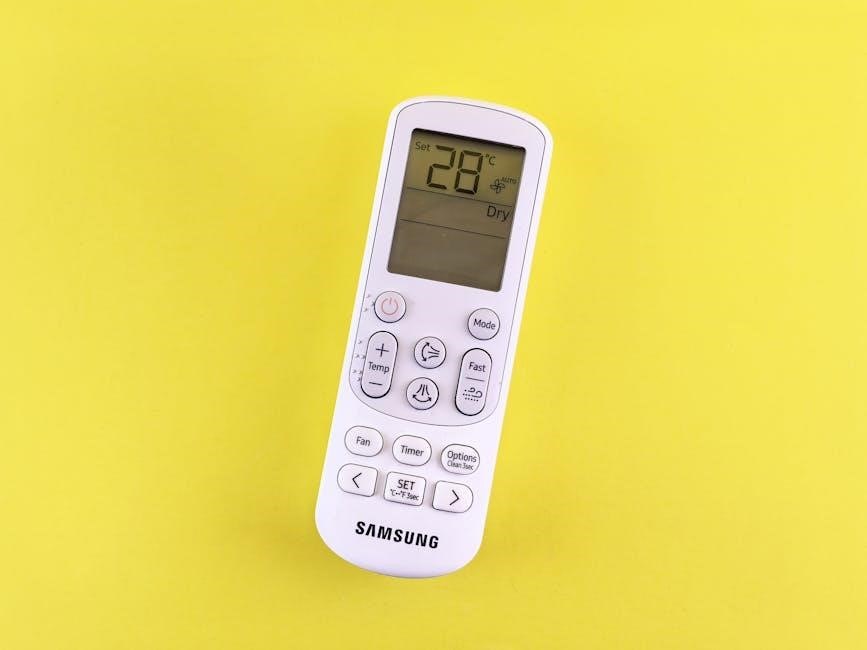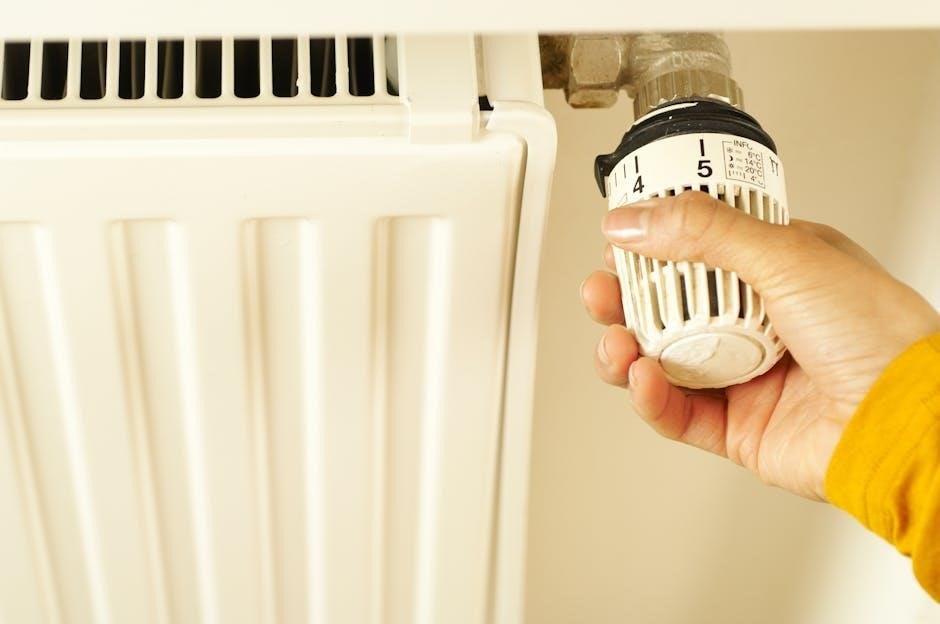alarm com thermostat manual
The Alarm.com Thermostat is a smart, energy-efficient solution for home automation, offering seamless integration with HVAC systems. This manual provides comprehensive guidance on installation, features, and troubleshooting to optimize your smart home experience.
1.1 Overview of the Alarm.com Thermostat
The Alarm.com Thermostat is a cutting-edge smart home device designed to integrate seamlessly with HVAC systems, offering advanced temperature control and energy management. It supports remote access, scheduling, and geofencing, enabling users to optimize their home’s climate and energy usage effortlessly. The thermostat is compatible with 24V non-proprietary HVAC systems and can be powered via a C-wire or batteries. Its intuitive interface and integration with the Alarm.com app allow for real-time monitoring and adjustments, ensuring maximum comfort and efficiency. The device also features advanced settings like temperature calibration and recovery modes, catering to both residential and small commercial applications. Proper installation requires turning off power at the circuit breaker, and while DIY installation is possible, professional assistance is recommended for complex systems. The thermostat is part of a broader smart home ecosystem, enhancing convenience and energy savings for users.
1.2 Importance of Using a Smart Thermostat
Using a smart thermostat like the Alarm.com Thermostat offers significant advantages for energy efficiency, convenience, and cost savings. These devices enable precise temperature control, reducing energy waste by learning your schedule and preferences. Remote access via the Alarm.com app allows users to adjust settings from anywhere, ensuring optimal comfort upon arrival home. Smart thermostats also provide detailed energy usage reports, helping you identify patterns and make informed decisions to lower utility bills. Features like geofencing automatically adjust temperatures based on your location, further enhancing efficiency. Additionally, compatibility with smart home systems integrates heating and cooling with other automation features, creating a seamless and modern living experience. By upgrading to a smart thermostat, homeowners can achieve long-term energy savings, reduce environmental impact, and enjoy unparalleled control over their home’s climate. This makes it an essential upgrade for anyone looking to enhance comfort and efficiency in their smart home setup.

Installation
Installing the Alarm.com Thermostat requires turning off power at the circuit breaker and ensuring safe wire connections. Use recommended tools for secure mounting and configuration. Proper installation ensures optimal functionality and energy efficiency.
2.1 Pre-Installation Preparation

Before installing the Alarm.com Thermostat, ensure the HVAC system is compatible with the thermostat. Verify the system is a 24 VAC, non-proprietary system. Turn off power at the circuit breaker and confirm it remains off. Gather necessary tools, such as a screwdriver, drill, and bubble level. Review the wiring diagram in the manual to understand connections. If replacing an old thermostat, note the existing wire configuration. Mark the screw holes on the wall using the back plate as a template. Use drywall anchors for added support if needed. Ensure the thermostat location provides accurate temperature readings. If unsure about any step, consult a licensed HVAC professional to avoid potential damage or safety risks. Proper preparation ensures a smooth and safe installation process.
2.2 Step-by-Step Installation Guide
Mount the back plate to the wall using the provided screws and drywall anchors. Ensure the plate is level using the built-in bubble level. If necessary, use the trim plate to cover any marks from the previous thermostat. Connect the wires to the terminal board, matching the labels from the old thermostat. Insert the batteries into the thermostat body, ensuring correct polarity. Attach the thermostat body to the back plate, aligning the pins with the header. Secure it firmly to ensure proper connection. Turn the power back on at the circuit breaker. Verify the thermostat powers on and perform a basic functionality test by checking heating and cooling modes. If issues arise, refer to the troubleshooting section or contact an HVAC professional for assistance.
2.3 Wiring and Connections

Before wiring, ensure the power to the HVAC system is turned off at the circuit breaker. Use the provided bubble level to align the back plate, marking screw holes with a pencil. Connect the wires to the terminal board, ensuring they match the labels from the old thermostat. If unsure, consult the wiring diagram or contact a professional. For systems requiring a C-wire, connect it to the “C” terminal on the thermostat. Extra wires should not be connected; instead, consult an HVAC technician. The thermostat can be powered by batteries or a 24VAC system. If using a wall transformer, connect it between the “C” and “RH” terminals. Ensure batteries are installed with correct polarity to avoid damage. After wiring, tuck excess wires into the wall to secure the thermostat body flush against the back plate. Proper connections are critical for system functionality and safety. Avoid connecting to high-voltage systems, as this requires professional expertise. Always test the system post-installation to ensure correct operation.
2.4 Configuring Initial Settings
After installation, configure the thermostat through your online Alarm.com account; Set system type, such as heat pump or conventional, and specify the number of heating and cooling stages. Choose the heating fuel type and calibrate the temperature if necessary. Configure terminal settings and enable features like geofencing or scheduling. Advanced settings, such as swing, differential, recovery, and fan circulation, can be adjusted for optimal performance. Set maximum and minimum temperature limits to prevent extreme conditions. You can also enable thermostat lock to restrict unauthorized changes. These settings ensure your HVAC system operates efficiently and according to your preferences. Proper configuration is essential for system performance and energy savings. Always refer to the manual or contact support for assistance with complex settings. Regularly review and update configurations to maintain optimal comfort and energy efficiency in your home.
2.5 Final Checks and Testing
After completing the installation and configuration, perform a thorough system check to ensure everything functions correctly. Restore power at the circuit breaker and verify that the thermostat display activates. Check all wire connections to confirm they are secure and properly labeled. Test the heating and cooling systems by setting the thermostat to different modes to ensure they activate and operate as expected. Verify that the temperature adjustments are responsive and accurate. If using geofencing or smart scheduling, test these features to ensure they work seamlessly with your lifestyle. Additionally, check the thermostat’s remote access through the Alarm.com app to confirm connectivity and control functionality. If any issues arise, refer to the troubleshooting section or contact your service provider for assistance. Proper testing ensures your system is optimized for comfort and energy efficiency. Always wait for mild weather conditions to fully test heating and cooling performance.
2.6 Troubleshooting Installation Issues
Common installation issues with the Alarm.com Thermostat often relate to wiring or system compatibility; If the thermostat fails to power on, ensure the circuit breaker is reset and all connections are secure. Check for loose wires and verify that the C-wire is correctly connected if required. If the system does not respond to temperature adjustments, verify that the correct HVAC type is selected in the configuration settings. For connectivity problems, ensure the thermostat is synced with your Alarm.com account and that your internet connection is stable. If the display is unresponsive, try restarting the thermostat by removing and reinserting the batteries. Refer to the user manual or contact your service provider for advanced troubleshooting steps. Addressing issues promptly ensures optimal performance and prevents potential system damage. Always follow safety guidelines and consult a professional if unresolved problems persist.

Features and Functionality
The Alarm.com Thermostat offers advanced features like remote temperature control, scheduling, geofencing, and energy usage reporting. It integrates seamlessly with smart home systems, providing enhanced comfort and energy efficiency for optimal performance.
3.1 Key Features Overview
The Alarm.com Thermostat offers a range of innovative features designed to enhance home comfort and energy efficiency. Key highlights include remote access through the Alarm.com app, enabling users to adjust settings from anywhere. The thermostat also supports scheduling, allowing for customized temperature plans that adapt to daily routines. Advanced geofencing technology automatically adjusts temperatures based on the user’s location, ensuring energy savings when the home is unoccupied; Additionally, the system provides detailed energy usage reports, giving insights into consumption patterns and helping users optimize their energy use. The thermostat is compatible with a variety of HVAC systems and integrates seamlessly with other smart home devices, making it a versatile and comprehensive solution for modern home automation needs. These features collectively ensure a convenient, efficient, and connected home environment.
3.2 Remote Access and Control

One of the standout features of the Alarm.com Thermostat is its remote access and control capabilities. Through the Alarm.com app, users can effortlessly manage their home’s temperature from any location with an internet connection; Whether adjusting the thermostat before returning home or modifying schedules while away, this feature offers unparalleled convenience. The app allows users to set temperatures, view current settings, and receive real-time updates on their HVAC system’s status. This remote functionality ensures that users can maintain optimal comfort levels without being physically present. Additionally, the app provides notifications for system events, such as when the thermostat is operating in heating or cooling mode, or if there are any issues requiring attention. This seamless integration of remote control enhances the overall smart home experience, making it easier than ever to manage energy usage and home comfort effectively. The Alarm.com Thermostat truly exemplifies modern smart home innovation with its intuitive and user-friendly remote access features.

3.3 Scheduling Capabilities
The Alarm.com Thermostat offers advanced scheduling capabilities that allow users to create custom temperature settings for different times of the day and week. Through the Alarm.com app, users can set up multiple schedules to align with their daily routines, ensuring optimal comfort and energy efficiency. Whether it’s adjusting the temperature before waking up, cooling down the house before arriving home, or setting a different schedule for weekends, the thermostat provides flexibility and precision. The system also supports geofencing technology, which uses the user’s location to automatically adjust temperatures when leaving or returning home; These scheduling features not only enhance convenience but also help reduce energy consumption by avoiding unnecessary heating or cooling when the house is unoccupied. With the Alarm.com Thermostat, users can effortlessly balance comfort and energy savings through intelligent scheduling options. This feature is a cornerstone of its smart home integration, making it a powerful tool for modern households.
3.4 Energy Usage Reports
The Alarm.com Thermostat provides detailed energy usage reports to help users monitor and manage their energy consumption effectively. These reports offer insights into heating and cooling patterns, identifying trends and opportunities to reduce waste. By analyzing historical data, users can track how their energy usage varies over time and make informed decisions to optimize efficiency. The system generates reports based on actual energy consumption, allowing homeowners to see the impact of their temperature settings and schedules. Additionally, the thermostat offers recommendations to lower energy usage without compromising comfort. Accessible via the Alarm.com app, these reports empower users to take control of their energy expenses and environmental impact. With the ability to view daily, weekly, or monthly summaries, the energy usage reports are a valuable tool for achieving energy savings and maintaining a sustainable home environment. This feature enhances the overall smart home experience by promoting awareness and responsible energy management.
3.5 Geofencing Technology
The Alarm.com Thermostat integrates advanced geofencing technology to automatically adjust temperature settings based on your location. This innovative feature uses your smartphone’s GPS to detect when you leave or arrive home, optimizing energy usage and comfort. By creating a virtual boundary around your home, the thermostat can trigger heating or cooling systems to turn on or off, ensuring energy is not wasted when the house is unoccupied. Users can customize the geofencing radius and set preferences for when the system should activate or deactivate. This smart automation not only saves energy but also enhances convenience, as it eliminates the need to manually adjust settings when leaving or returning home. The geofencing technology seamlessly integrates with other features, such as scheduling and remote access, to provide a holistic smart home experience. This feature is particularly beneficial for busy households, offering both efficiency and comfort.
3.6 System Compatibility
The Alarm;com Thermostat is designed to work seamlessly with a wide range of HVAC systems, ensuring compatibility for various home setups. It supports 24 VAC non-proprietary systems, including heat pumps, dual-fuel systems, and conventional heating and cooling units. The thermostat is also compatible with systems that require a C wire connection, ensuring reliable power delivery. For systems without a C wire, the thermostat can operate on battery power, though the C wire is recommended for optimal performance. Additionally, it integrates with Z-Wave and Bluetooth technologies, enhancing smart home connectivity. Before installation, it is crucial to verify that your HVAC system meets these compatibility requirements to avoid any issues. If unsure, consulting a professional HVAC technician is recommended to ensure proper installation and functionality. This broad compatibility makes the Alarm.com Thermostat a versatile choice for modern smart home systems. Always check the user manual for specific compatibility details and guidelines.

Advanced Settings
Explore temperature calibration, recovery settings, fan circulation, and set point adjustments for enhanced control. Secure your settings with thermostat lock features to maintain preferred configurations efficiently.
4.1 Temperature Calibration
Temperature calibration ensures your Alarm.com Thermostat accurately reads and maintains your desired temperature. To calibrate, access the advanced settings menu through your online account. Adjust the offset value in 0.5-degree increments to correct any discrepancies between the displayed temperature and the actual room temperature. Proper calibration is crucial for efficient heating and cooling, preventing unnecessary energy usage. If your system is connected to a C-wire, the thermostat will continuously monitor and adjust for accuracy. For systems without a C-wire, ensure batteries are fresh to maintain reliable performance. Refer to page 12 in the manual for detailed calibration steps or contact your HVAC professional for assistance. Regular calibration is recommended to optimize comfort and energy savings.
4.2 Recovery Settings
Recovery settings on the Alarm.com Thermostat allow you to optimize how your HVAC system returns to the desired temperature after a setback or during startup. This feature ensures the system operates efficiently, avoiding excessive heating or cooling. To configure recovery settings, access the advanced menu through your online account. Adjust the recovery time to match your system’s performance, ensuring it reaches the set temperature precisely when needed. For heat pumps, this setting prevents unnecessary auxiliary heat activation, saving energy. Properly configured recovery settings balance comfort and efficiency, especially during extreme weather. Refer to page 12 for detailed instructions or consult your HVAC professional for assistance. Regular review of these settings ensures optimal performance and energy savings.
4.3 Fan Circulation Settings
The Alarm.com Thermostat offers fan circulation settings to enhance air distribution and system efficiency. These settings allow you to control the fan’s operation, ensuring consistent airflow even when heating or cooling is not active. By enabling fan circulation, you can improve indoor air quality and reduce hot or cold spots in your home. The fan can be set to run continuously or intermittently, with adjustable duty cycles to balance energy usage and comfort. Proper configuration of these settings can lower energy costs by reducing the need for frequent heating or cooling cycles. For optimal performance, refer to the advanced settings menu in your online account or consult the manual. Adjusting fan circulation settings should be done carefully to avoid unnecessary energy consumption. If unsure, contact an HVAC professional for assistance. Regular monitoring of these settings ensures your system operates efficiently and maintains a comfortable living environment year-round.
4.4 Maximum and Minimum Set Points
The Alarm.com Thermostat allows you to set maximum and minimum temperature limits to maintain a comfortable environment while optimizing energy use. These set points prevent extreme temperatures, ensuring your system operates within safe and efficient ranges. Setting a maximum limit prevents overheating during summer, while a minimum limit avoids excessive cooling. Adjusting these parameters can be done through the thermostat’s interface or your online account. It is important to configure these settings based on your specific needs to avoid unnecessary energy consumption. If you encounter issues or need further customization, consult the manual or contact an HVAC professional. Regularly reviewing these settings ensures your system continues to function efficiently and effectively, providing consistent comfort while managing energy costs. Proper configuration of maximum and minimum set points is essential for balancing comfort and energy savings in your home.
4.5 Thermostat Lock Features
The Alarm.com Thermostat offers lock features to prevent unauthorized changes to settings, ensuring consistent temperature control. This feature is ideal for homes with multiple users or for maintaining energy-saving settings. The thermostat lock can be configured to require a PIN or password before any adjustments are made. You can choose between partial or full lock modes, allowing limited access for guests or service providers while restricting full control. To enable this feature, navigate to the advanced settings menu on the thermostat or through your online account. Once activated, the thermostat will prompt for authentication before any changes. This feature helps maintain your preferred settings and reduces energy waste from unintended adjustments. For additional security, the lock can be disabled temporarily for maintenance or adjustments. Always refer to the manual for detailed instructions on configuring and managing the lock features effectively. This ensures your thermostat remains secure and operates according to your preferences.

Maintenance and Troubleshooting
Regularly check and clean the thermostat to ensure optimal performance. For common issues like sensor errors, refer to the troubleshooting guide. Resetting the thermostat can often resolve connectivity or display problems. If issues persist, contact a professional for assistance.
5.1 Routine Maintenance Tips
Regular maintenance ensures your Alarm.com Thermostat operates efficiently. First, clean the display and sensors with a soft cloth to prevent dust buildup. Replace batteries annually if not using a C-wire connection. Check wiring connections for tightness and integrity. Verify system compatibility and update software regularly. Schedule professional HVAC inspections annually to maintain optimal performance and integration with your thermostat. Always turn off power at the circuit breaker before performing any maintenance. Follow these tips to extend the lifespan and functionality of your smart thermostat.
5.2 Common Issues and Solutions
Common issues with the Alarm.com Thermostat include connectivity problems or unresponsive displays. For connectivity issues, restart the thermostat and ensure stable internet connection; If the display is unresponsive, check battery levels or C-wire connection. Temperature inaccuracies may require recalibration in settings. If heating or cooling systems fail to activate, verify wiring connections and system compatibility. For persistent issues, refer to the user manual or contact Alarm.com support. Troubleshooting steps often resolve issues without professional intervention, ensuring optimal performance.
5.3 Resetting the Thermostat

Resetting the Alarm.com Thermostat can resolve various issues without affecting custom settings. To perform a soft reset, turn off power at the circuit breaker for 30 seconds, then restore it. For a factory reset, press and hold the “Menu” and “Back” buttons simultaneously for 10 seconds until the screen resets. If resetting via the Z-Wave network, exclude the thermostat from the network and re-include it. Always ensure the C-wire is securely connected to prevent power issues. After resetting, recalibrate temperature settings and reconfigure system preferences. If problems persist, contact your Alarm.com service provider for assistance. Regular resets can help maintain optimal performance and ensure seamless integration with your HVAC system.
